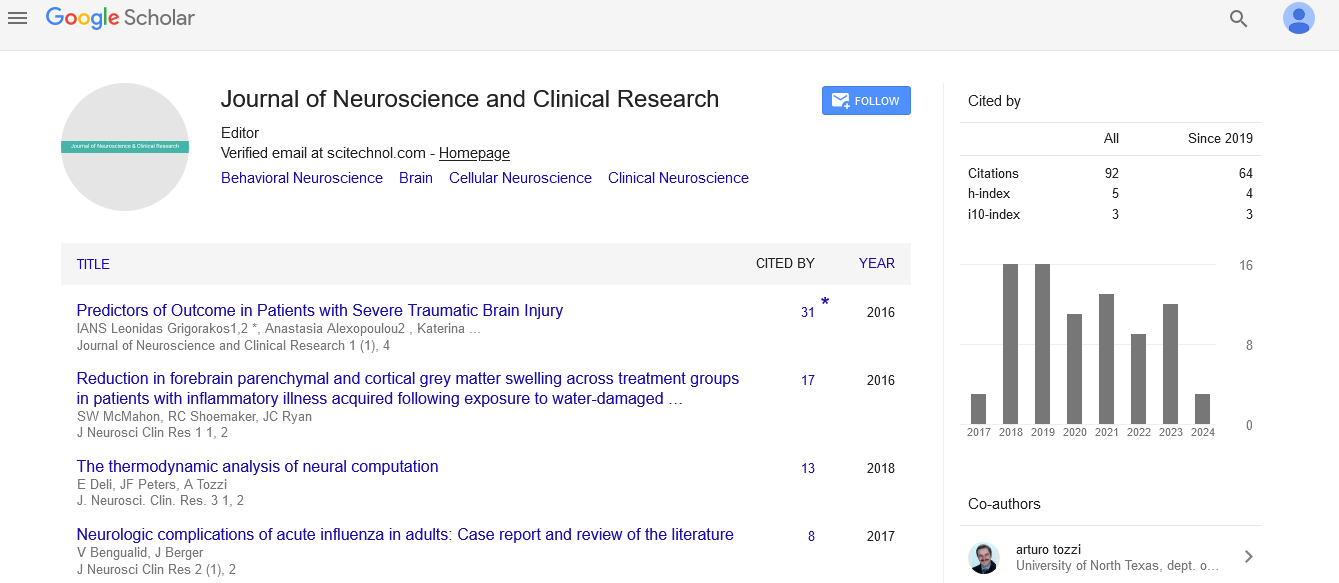Commentary, J Neurosci Clin Res Vol: 9 Issue: 2
Cellular Responses in Neural Pathology: Neurons, Neuroglia and Connective Tissues
Chrstian Buyukuztirk*
1Department of Mechanical Engineering, University of Wisconsin-Madison, 1513 University Ave, Madison, WI 53706, USA
*Corresponding Author: Chrstian Buyukuztirk,
Department of Mechanical
Engineering, University of Wisconsin-Madison, 1513 University Ave, Madison, WI
53706, USA
E-mail: buyukuztirk@gmail.com
Received date: 28 May, 2024, Manuscript No. JNSCR-24-137115;
Editor assigned date: 30 May, 2024, PreQC No. JNSCR-24-137115 (PQ);
Reviewed date: 14 June, 2024, QC No. JNSCR-24-137115;
Revised date: 21 June, 2024, Manuscript No. JNSCR-24-137115 (R);
Published date: 28 June, 2024, DOI: 10.4172/Jnscr.1000192
Citation: Buyukuztirk C (2024) Cellular Responses in Neural Pathology: Neurons, Neuroglia and Connective Tissues. J Neurosci Clin Res 9:2.
Abstract
The nervous system's intricate network comprises various cell types, each playing a critical role in maintaining its functionality and integrity. When subjected to disease and traumatic events, these cellular components-neurons, neuroglia, connective tissues, blood vessels, meninges, and peripheral nerves-exhibit distinct responses aimed at repair and protection. Understanding these cellular reactions is important for developing therapeutic strategies to mitigate damage and promote recovery.
Neurons, the primary signaling cells of the nervous system, are highly susceptible to damage from both disease and trauma. When injured, neurons can undergo several changes. In response to acute trauma or neurodegenerative diseases, excessive glutamate release can lead to excitotoxicity, causing neuronal damage and death through overactivation of NMDA receptors and subsequent calcium influx. Neurons can die via apoptosis (programmed cell death) or necrosis (uncontrolled cell death). Apoptosis is a more controlled process, often activated by internal cellular stress or external signals, whereas necrosis is typically a result of severe injury leading to cellular rupture and inflammation. In the Peripheral Nervous System (PNS), neurons have a greater capacity for regeneration compared to the Central Nervous System (CNS). Schwann cells in the PNS support axonal regrowth by creating a conducive environment for repair. In the CNS, neurons exhibit limited regenerative capacity, but neuroplasticity-the ability to form new synaptic connections-can partially compensate for lost functions. Neuroglia, including astrocytes, oligodendrocytes, and microglia, play vital roles in supporting and protecting neurons.
Astrocytes respond to injury by undergoing astrogliosis, characterized by hypertrophy and proliferation. This response can form a glial scar, which isolates the damaged area to prevent further injury but may also impede axonal regrowth. Responsible for myelinating CNS axons, oligodendrocytes are vulnerable to demyelinating diseases like multiple sclerosis. When damaged, oligodendrocytes can attempt remyelination, although this process is often inefficient and incomplete. Microglia act as the CNS's resident immune cells. Upon detecting injury or disease, they become activated, migrating to the site of damage, phagocytosing debris, and releasing cytokines. Chronic activation, however, can contribute to neuroinflammation and exacerbate neuronal damage. Connective tissues and blood vessels provide structural and functional support to the nervous system. The BBB, composed of endothelial cells, astrocyte end-feet, and pericytes, protects the CNS from harmful substances. Disruption of the BBB due to trauma or disease can lead to edema, inflammation, and increased vulnerability to toxins and pathogens.
In response to injury, angiogenesis (the formation of new blood vessels) can occur to restore oxygen and nutrient supply to the affected area. However, abnormal angiogenesis can lead to leaky vessels and contribute to edema. The ECM provides a scaffold for cells and influences cell behavior. After injury, ECM components can be upregulated to facilitate tissue repair, but excessive ECM deposition can form a physical barrier to axonal regrowth. The meninges, comprising the dura mater, arachnoid mater, and pia mater, protect the brain and spinal cord. Infections such as meningitis cause meningeal inflammation, leading to increased intracranial pressure and potential neuronal damage. Anti-inflammatory treatments are crucial to mitigate these effects.
Following trauma or surgery, meningeal fibrosis can occur, resulting in scar tissue formation that may restrict cerebrospinal fluid flow and contribute to conditions like hydrocephalus. Peripheral nerves, consisting of axons, Schwann cells, and connective tissues, have a remarkable capacity for regeneration. Following axonal injury, the distal segment undergoes Wallerian degeneration, where axons and myelin sheaths disintegrate. Schwann cells play a pivotal role in clearing debris and guiding regenerating axons. Peripheral nerves can regenerate if the cell body remains intact. Schwann cells secrete neurotrophic factors and form bands of Büngner to support axonal regrowth and functional recovery.
Conclusion
The cellular responses to neural pathology are complex and multifaceted, involving coordinated actions from neurons, neuroglia, connective tissues, blood vessels, meninges, and peripheral nerves. These responses are important for limiting damage, facilitating repair, and restoring function. Advances in understanding these mechanisms hold promise for developing targeted therapies to enhance neural repair and improve outcomes for individuals suffering from neurological diseases and injuries. injury triggers complex processes like angiogenesis and ECM modulation for tissue repair, while also posing risks such as leaky vessels and excessive scarring. The meninges and peripheral nerves play crucial roles in protecting and regenerating neural tissues, highlighting the importance of managing inflammation and supporting nerve recovery for optimal healing.
 Spanish
Spanish  Chinese
Chinese  Russian
Russian  German
German  French
French  Japanese
Japanese  Portuguese
Portuguese  Hindi
Hindi 